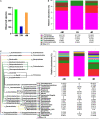Evaluation of an Antibiotic Cocktail for Fecal Microbiota Transplantation in Mouse
- PMID: 35719145
- PMCID: PMC9204140
- DOI: 10.3389/fnut.2022.918098
Evaluation of an Antibiotic Cocktail for Fecal Microbiota Transplantation in Mouse
Abstract
Objective: This study aimed to evaluate the effect of an antibiotic cocktail on gut microbiota and provide a reference for establishing an available mouse model for fecal microbiota transplantation (FMT) of specific microbes.
Design: C57BL/6J mice (n = 24) had free access to an antibiotic cocktail containing vancomycin (0.5 g/L), ampicillin (1 g/L), neomycin (1 g/L), and metronidazole (1 g/L) in drinking water for 3 weeks. Fecal microbiota was characterized by 16S rDNA gene sequencing at the beginning, 1st week, and 3rd week, respectively. The mice were then treated with fecal microbiota from normal mice for 1 week to verify the efficiency of FMT.
Results: The diversity of microbiota including chao1, observed species, phylogenetic diversity (PD) whole tree, and Shannon index were decreased significantly (P < 0.05) after being treated with the antibiotic cocktail for 1 or 3 weeks. The relative abundance of Bacteroidetes, Actinobacteria, and Verrucomicrobia was decreased by 99.94, 92.09, and 100%, respectively, while Firmicutes dominated the microbiota at the phylum level after 3 weeks of treatment. Meanwhile, Lactococcus, a genus belonging to the phylum of Firmicutes dominated the microbiota at the genus level with a relative abundance of 80.63%. Further FMT experiment indicated that the fecal microbiota from the receptor mice had a similar composition to the donor mice after 1 week.
Conclusion: The antibiotic cocktail containing vancomycin, ampicillin, neomycin, and metronidazole eliminates microbes belonging to Bacteroidetes, Actinobacteria, and Verrucomicrobia, which can be recovered by FMT in mice.
Keywords: antibiotic cocktail; fecal microbiota transplantation; gut microbiota; mouse model; pretreatment.
Copyright © 2022 Tan, Gong, Liu, Li, Li, You, He and Wu.
Conflict of interest statement
The authors declare that the research was conducted in the absence of any commercial or financial relationships that could be construed as a potential conflict of interest.
Figures





Similar articles
-
Effects of antibiotic cocktail on the fecal microbiota and their potential correlation of local immune response.BMC Microbiol. 2024 Jul 31;24(1):283. doi: 10.1186/s12866-024-03424-z. BMC Microbiol. 2024. PMID: 39085808 Free PMC article.
-
[Preliminary study on the effect of fecal microbiota transplantation on neurobehavior and gut microbiota of offspring rats exposed to arsenic].Zhonghua Lao Dong Wei Sheng Zhi Ye Bing Za Zhi. 2023 Jan 20;41(1):14-20. doi: 10.3760/cma.j.cn121094-20220311-00125. Zhonghua Lao Dong Wei Sheng Zhi Ye Bing Za Zhi. 2023. PMID: 36725289 Chinese.
-
Refining a Protocol for Faecal Microbiota Engraftment in Animal Models After Successful Antibiotic-Induced Gut Decontamination.Front Med (Lausanne). 2022 Feb 9;9:770017. doi: 10.3389/fmed.2022.770017. eCollection 2022. Front Med (Lausanne). 2022. PMID: 35223890 Free PMC article.
-
[Fecal microbiota transplantation in the treatment of acute intestinal pseudo obstruction secondary to intracerebral hemorrhage: a case report and literature review].Zhonghua Wei Zhong Bing Ji Jiu Yi Xue. 2022 Mar;34(3):306-310. doi: 10.3760/cma.j.cn121430-20220225-00179. Zhonghua Wei Zhong Bing Ji Jiu Yi Xue. 2022. PMID: 35574751 Review. Chinese.
-
16S rDNA analysis of the effect of fecal microbiota transplantation on pulmonary and intestinal flora.3 Biotech. 2017 Dec;7(6):370. doi: 10.1007/s13205-017-0997-x. Epub 2017 Oct 12. 3 Biotech. 2017. PMID: 29071167 Free PMC article. Review.
Cited by
-
High-fat diet feeding exacerbates HIV-1 rectal transmission.mSystems. 2024 Mar 19;9(3):e0132223. doi: 10.1128/msystems.01322-23. Epub 2024 Feb 2. mSystems. 2024. PMID: 38303112 Free PMC article.
-
Effects of antibiotic cocktail on the fecal microbiota and their potential correlation of local immune response.BMC Microbiol. 2024 Jul 31;24(1):283. doi: 10.1186/s12866-024-03424-z. BMC Microbiol. 2024. PMID: 39085808 Free PMC article.
-
Comparative Colonisation Ability of Human Faecal Microbiome Transplantation Strategies in Murine Models.Microb Biotechnol. 2025 Jun;18(6):e70173. doi: 10.1111/1751-7915.70173. Microb Biotechnol. 2025. PMID: 40448308 Free PMC article.
-
The changes of intestinal flora and metabolites in atopic dermatitis mice.Front Microbiol. 2024 Dec 16;15:1462491. doi: 10.3389/fmicb.2024.1462491. eCollection 2024. Front Microbiol. 2024. PMID: 39736988 Free PMC article.
-
Lactobacillus murinus Reduces Susceptibility to Secondary MRSA Infection in IAV-Infected Mice Through Promoting a T Cell-Independent IgA Response.Microorganisms. 2025 Jul 21;13(7):1709. doi: 10.3390/microorganisms13071709. Microorganisms. 2025. PMID: 40732218 Free PMC article.
References
-
- Zhang XY, Chen J, Yi K, Peng L, Xie J, Gou X, et al. Phlorizin ameliorates obesity-associated endotoxemia and insulin resistance in high-fat diet-fed mice by targeting the gut microbiota and intestinal barrier integrity. Gut Microbes. (2020) 12:1–18. 10.1080/19490976.2020.1842990 - DOI - PMC - PubMed
LinkOut - more resources
Full Text Sources

